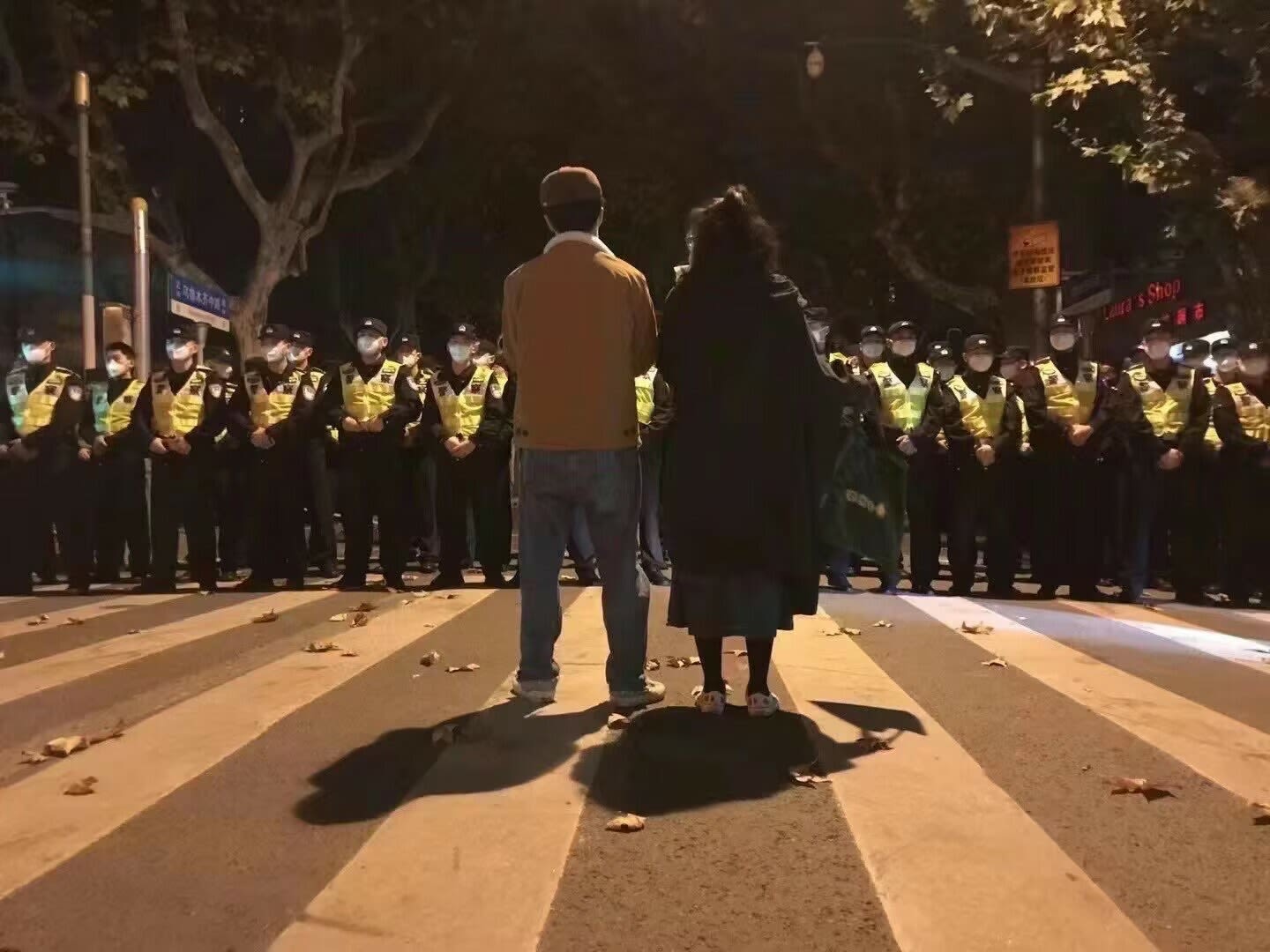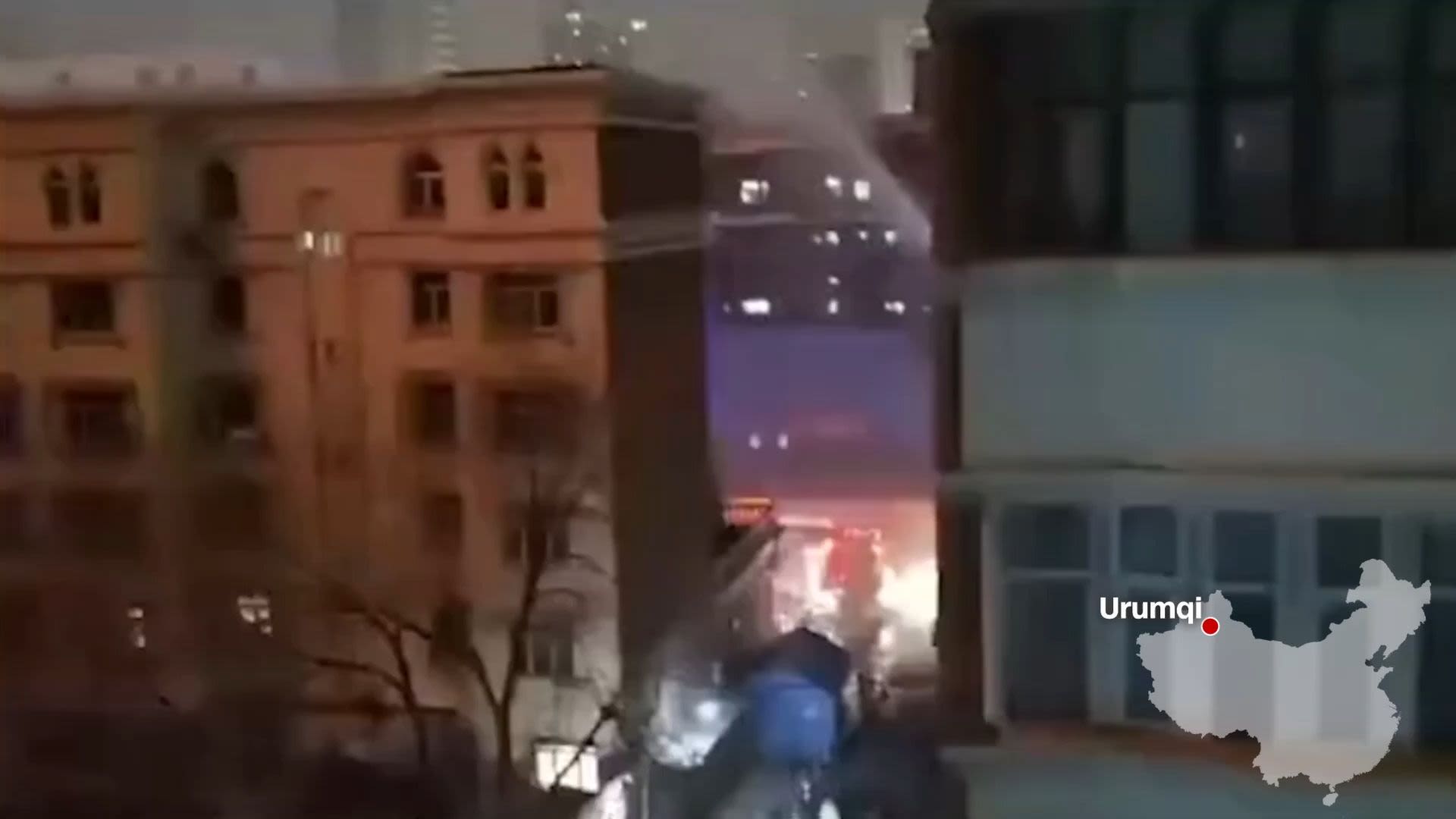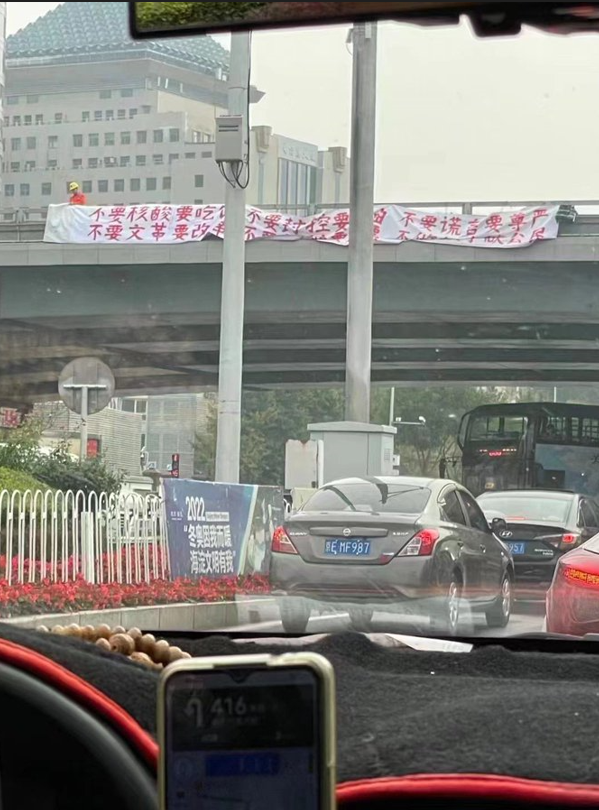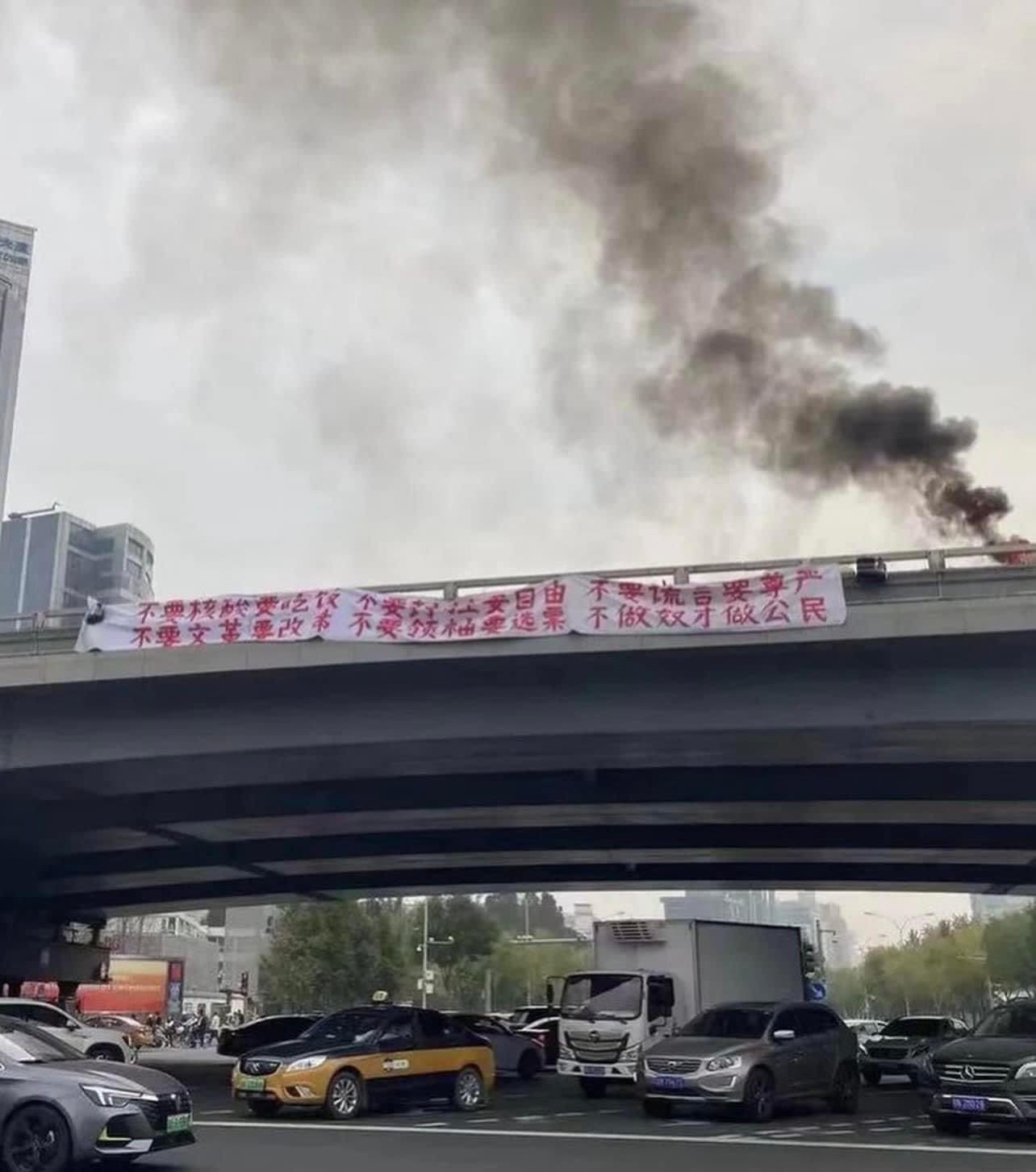Breaking the Blockade
How a deadly fire ignited dissent over China’s zero-Covid policy

Stunning scenes of dissent and defiance played out across China over the past week, marking the country’s largest protests in decades – and an unprecedented challenge to leader Xi Jinping.
Deep public anger after nearly three years of snap lockdowns, border closures and financial hardship brought thousands out onto the streets to demand an end to mainland China’s zero-Covid policy – with some also calling for democracy.
The country’s security forces moved swiftly to snuff out the protests, while health officials tried to appease the public by promising to soften tough Covid measures. But furious posts on Chinese social media, which continued despite censors’ best efforts, suggested it wasn’t enough.

High-rise building after the deadly fire in Urumqi. Credit: Twitter
High-rise building after the deadly fire in Urumqi. Credit: Twitter
Deadly Fire
On November 24, Ali Abbas’ granddaughter was charging her tablet device when an electrical fault causDeadly Fireed smoke to fill their Urumqi home, in China’s far western Xinjiang region, he told CNN on the phone from Turkey.
Smoke quickly turned to flames, which raced through the wood-furnished apartment. Abbas’ granddaughter and daughter were able to evacuate – but residents on higher floors found themselves stranded after the elevator stopped working.
State-run media reported the fire killed 10 people and injured nine, but reports from local residents suggest the real toll is far higher. A day after the blaze, Urumqi local government officials denied the city’s Covid policies were to blame for the deaths, adding that an investigation was underway.

"What happened to my neighbors is really a big disaster. I would like to express my sincere sorrow to all Uyghur people, to all those loved ones who lost their family members."
Public anger quickly swelled. Videos online showed people marching to a government building in Urumqi on the night of November 25, demanding an end to the lockdown, chanting with fists in the air. Residents in other parts of the city broke through lockdown barriers and confronted Covid workers dressed in PPE; at one point, the crowd sang the national anthem, roaring the chorus: “Arise, arise, arise!”
The scenes were extraordinary in a city subject to some of China’s most stringent surveillance and security. The government has long been accused of committing human rights abuses against ethnic Uyghurs and other minorities in the region, including placing up to 2 million people in internment camps. Beijing has repeatedly denied these accusations, claiming the camps are vocational training centers.
The next morning, the Urumqi government said it would gradually ease the lockdown in certain areas. But by then, it was too late to quell the protests erupting across the nation.
Lianxing Community, 104 Corps, Urumqi, Xinjiang, 25th Nov. Credit: Twitter
Lianxing Community, 104 Corps, Urumqi, Xinjiang, 25th Nov. Credit: Twitter
Mounting frustrations
The protests tapped into a well of anger that had been brewing over China’s zero-Covid policy – and the damage it has often caused – as the rest of the world ended lockdown restrictions and eased other mandates, including masking.
The cost has been immense. Unemployment has skyrocketed. The economy is flailing. Those trapped in unexpected lockdowns have found themselves without adequate food, basic supplies, or even medical care in non-Covid emergencies.
And, like those in the Urumqi fire, many deaths have been blamed on the zero-Covid policy in the last six months – far more than the six official Covid deaths reported during the same period. Demands for accountability are growing, especially after a September bus crash that killed 27 people while transporting residents to a Covid quarantine facility, and the November death of a toddler during a suspected gas leak in a locked-down residential compound.

Beijing Sitong Bridge protest, 13 October 2022
Beijing Sitong Bridge protest, 13 October 2022
The policy had been broadly popular at the start of the pandemic, but many residents have now had enough. In a rare demonstration in October, a sole protester hung banners on a Beijing bridge that decried Covid restrictions and demanded Xi’s removal.
Though all references to the banners were wiped from the Chinese internet, versions of those slogans began appearing in other parts of the country and in universities around the world – scrawled on bathroom walls and pinned on bulletin boards. More acts of disobedience came in November; workers fled China’s largest iPhone assembly factory in Zhengzhou when it was placed under lockdown, while residents of Guangzhou, also a manufacturing hub, tore down lockdown barriers and surged onto the streets in a nighttime revolt.
From June to November 22, American think tank Freedom House recorded at least 79 protests against Covid restrictions, spanning from social media campaigns to gatherings on the street. But most of these voiced grievances against local authorities – a far cry from some of the nationwide protests that, for the first time in a generation, took aim at the country’s powerful leader and central government.


An unprecedented wave of protest

The protests in Urumqi quickly sparked more across the country.
On November 26, from the original epicenter of the pandemic in Wuhan,
to the capital Beijing, and Shanghai, China’s glitzy financial hub, which still carries the trauma of its own two-month lockdown earlier this year.
Hundreds of Shanghai residents gathered on November 26 for a candlelight vigil for the victims of the fire. Grief turned to anger as the crowd chanted slogans calling for freedom and political reform, while holding blank sheets of paper in a symbolic protest against censorship.
Urumqi Middle Road, Shanghai, 27th Nov. credit: Twitter
Urumqi Middle Road, Shanghai, 27th Nov. credit: Twitter
Around 300 kilometres (186 miles) away, dozens of students in Nanjing gathered to mourn the victims, with photos showing a crowd of young people lit by cell phone flashlights.

Communication University of China, Nanjing, 27th Nov
Communication University of China, Nanjing, 27th Nov
Images of the protests raced across social media faster than censors could erase them – igniting demonstrations in other university campuses, including the prestigious Peking University in Beijing.

Peking University, 27th Nov
Peking University, 27th Nov
One wall at Peking University bore a message in red paint, echoing the slogans used by the protester who had hung the Beijing bridge banners in October:
“Say no to lockdown, yes to freedom.”
On November 27, Beijing emerged as a protest hotspot, as hundreds of students gathered at the elite Tsinghua University, shouting: “Democracy and rule of law! Freedom of expression!”
Protest in front of the Bauhinia Canteen at Tsinghua University, Beijing, 27th Nov
Elsewhere in the city, a large crowd gathered for a vigil and a march through the commercial center, chanting slogans for greater civil liberties.
Beijing Liangmaqiao, 27th Nov. Credit: Twitter
Beijing Liangmaqiao, 27th Nov. Credit: Twitter
"It turns out there are so many people who are wide awake."

Online, China’s vast army of censors worked overtime to erase content about the demonstrations – prompting many to get creative. Some posts on social media consisted only of one or two characters repeated for several paragraphs, in the long tradition of using codes and wordless icons to convey dissent on China’s internet.
Similar tactics were used on the ground, with videos on social media showing crowds shouting, “We want lockdowns, we want tests” after reportedly being told not to chant the opposite.

University of Chinese Academy of Social Sciences, Bejing, 27th Nov
University of Chinese Academy of Social Sciences, Bejing, 27th Nov
Some of these protests dispersed peacefully, while several escalated into scuffles with police. In Shanghai, one protester told CNN around 80 to 110 people had been detained by police on the night of November 26, adding they were released 24 hours later after officers collected their fingerprints and retina patterns.
CNN cannot independently verify the number of protesters detained and it is unclear how many people, if any, remain in custody.

Crackdown and concessions

At the same time as the crackdown, health officials tried to appease the public, acknowledging in a news conference on Tuesday that some Covid control measures had been implemented “excessively.” Authorities were adjusting measures to “limit the impact on people as much as possible,” they said, reiterating similar recent statements.
The promises failed to soothe some listeners who seethed in comments on Weibo, China’s equivalent of Twitter, where the conference was livestreamed. “You’ve lost all credibility,” one said. Another wrote: “We’ve cooperated with you for three years. Now, it’s time to give our freedom back.”
The following day, a top official gave the clearest indication yet that the country was considering a new direction.
“With the decreasing toxicity of the Omicron variant, the increasing vaccination rate and the accumulating experience of outbreak control and prevention, China’s pandemic containment faces (a) new stage and mission,” said Vice Premier Sun Chunlan, who oversees the country’s Covid response, according to state media.
Several cities moved quickly to loosen restrictions. On Friday, Beijing’s municipal government reversed rules set just 10 days ago that required residents to show a negative Covid-19 test taken in the previous 48 hours to board public transport in the capital city.
Tianjin and Chengdu also scrapped requirements for commuters to present a negative test result, effective immediately, according to notices from both cities’ metro operators on Friday.
In Chongqing and Guangzhou, close contacts of positive cases can quarantine at home instead of at a government facility. Several lockdowns were also lifted, including in Zhengzhou and in Guangzhou.

While these measures are expected to bring some relief, authorities have repeatedly voiced concerns that vaccination rates aren’t high enough to fully open up without risking spikes in Covid deaths.
China recorded 34,772 new Covid cases on Thursday, then 32,827 on Friday, continuing a downward trend in daily infections from record highs on November 27.
As of Friday, thousands of buildings and residential communities across China remain under lockdown restrictions due to their classification as “high risk.”
One user on Weibo urged authorities to further relax rules “so people can live a normal life,” warning that strict Covid measures could push some too far.
“If they don’t open up soon, people will really go crazy,” one comment read.
Another wrote: “The pressure is too great.”
CNN’s Beijing bureau, Steven Jiang, Nectar Gan, Simone McCarthy, Louis Leeson, Rebecca Wright and Ivan Watson contributed reporting.
